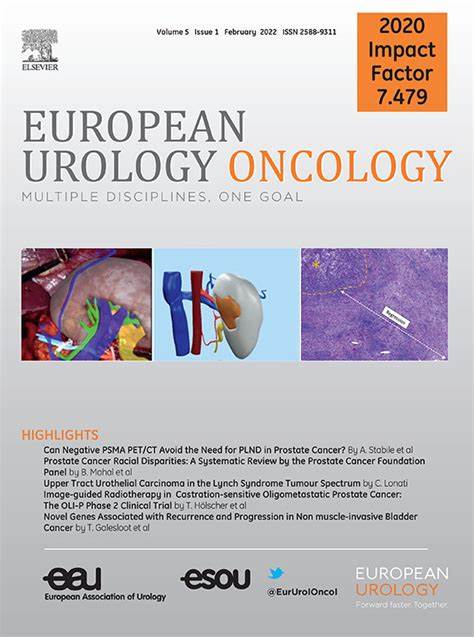辅助多西紫杉醇与监测在中度或高危前列腺癌根治性放疗后:SPCG-13试验的最终生存结果
IF 9.3
1区 医学
Q1 ONCOLOGY
引用次数: 0
摘要
SPCG-13试验研究了6个周期的辅助多西他赛(aDoc)是否能提高中高危前列腺癌患者根治性放疗和雄激素剥夺治疗后的生存率。在监测组(SV)和aDoc组之间,5年生化无复发生存期(主要终点)没有差异。在这里,我们报告了10年的生存数据(计划的次要终点)。更新了233例患者的总生存期(OS)和无转移生存期数据。在最初的随机队列和10年生存率人群之间没有人口统计学差异。因此,这个10年的样本被认为是原始患者群体的代表。SV组的中位总生存期为14.5年,aDoc组未达到中位总生存期。随时间推移,两组间Kaplan-Meier生存率无显著差异(log-rank检验p = 0.154)。对10年OS率的估计更倾向于aDoc(77.4%对66.8%)。Cox回归分析显示,高Gleason评分(GS;风险比[HR] 1.925, 95%可信区间[CI] 1.213-3.053;p = 0.005)。校正GS风险的Cox模型显示OS HR为0.776 (95% CI 0.508-1.187;p = 0.242)。总之,aDoc与10年OS的轻微改善有关,但没有统计学意义,特别是在高gs组。患者总结:我们对SPCG-13试验的10年生存分析显示,中度或高危局限性前列腺癌患者在放疗和雄激素剥夺治疗后进行6个周期的多西他赛化疗并没有显著提高生存率。Gleason评分高的癌症患者生存率更差,因此在仔细讨论化疗的利弊后,可以考虑使用多西他赛。需要进一步的试验来研究这组患者的选择。本文章由计算机程序翻译,如有差异,请以英文原文为准。
Adjuvant Docetaxel Versus Surveillance in Intermediate- or High-risk Prostate Cancer After Radical Curative Radiotherapy: Final Survival Results from the SPCG-13 Trial
The SPCG-13 trial investigated whether six cycles of adjuvant docetaxel (aDoc) improves survival in patients with intermediate- or high-risk prostate cancer after radical curative radiotherapy and androgen deprivation therapy. There was no difference in biochemical recurrence–free survival (primary endpoint) at 5-yr between the surveillance (SV) and aDoc arms. Here we report 10-yr survival data (planned secondary endpoint). Updated overall survival (OS) and metastasis-free survival data were available for 233 patients. There were no demographic differences between the original randomized cohort and the 10-yr survival population. Thus, this 10-yr sample is deemed representative of the original patient population. Median OS was 14.5 yr in the SV and was not reached in the aDoc arm. No significant difference in Kaplan-Meier survival emerged between the arms over time (log-rank test p = 0.154). Estimates of the 10-yr OS rate favored aDoc (77.4% vs 66.8%). Cox regression analysis revealed a trend towards worse OS for patients with a high Gleason score (GS; hazard ratio [HR] 1.925, 95% confidence interval [CI] 1.213–3.053; p = 0.005). A Cox model adjusted for GS risk revealed an OS HR of 0.776 (95% CI 0.508–1.187; p = 0.242) for aDoc versus SV. In conclusion, aDoc was associated with a slight, but not statistically significant, improvement in 10-yr OS, especially in the high-GS group.
Patient summary
Our 10-year survival analysis for the SPCG-13 trial showed that six cycles of chemotherapy with docetaxel after radiotherapy and androgen deprivation therapy for intermediate- or high-risk localized prostate cancer did not significantly increase survival. Survival was worse for cancers with a high Gleason score, so docetaxel could be considered after a careful discussion of the benefits and harms of chemotherapy. Further trials are needed to investigate options for this group of patients.
求助全文
通过发布文献求助,成功后即可免费获取论文全文。
去求助
来源期刊

European urology oncology
Multiple-
CiteScore
15.50
自引率
2.40%
发文量
128
审稿时长
20 days
期刊介绍:
Journal Name: European Urology Oncology
Affiliation: Official Journal of the European Association of Urology
Focus:
First official publication of the EAU fully devoted to the study of genitourinary malignancies
Aims to deliver high-quality research
Content:
Includes original articles, opinion piece editorials, and invited reviews
Covers clinical, basic, and translational research
Publication Frequency: Six times a year in electronic format
 求助内容:
求助内容: 应助结果提醒方式:
应助结果提醒方式:


